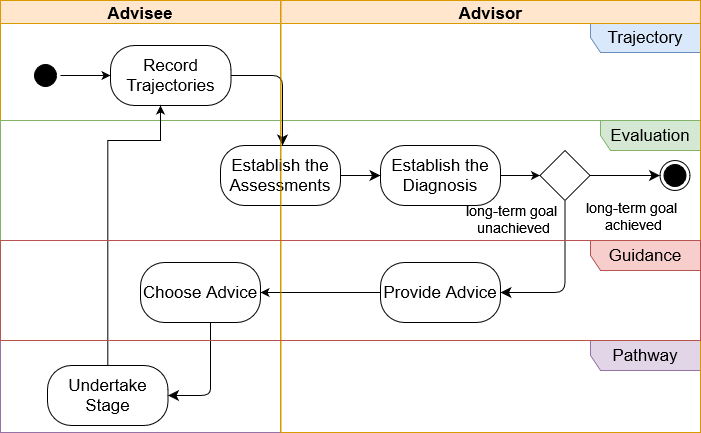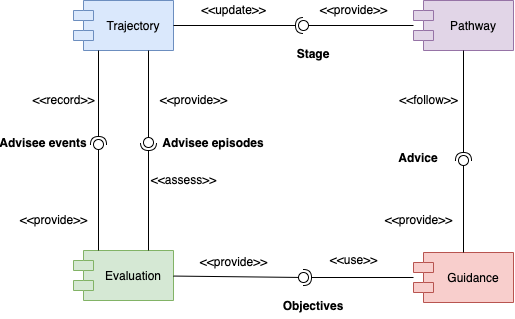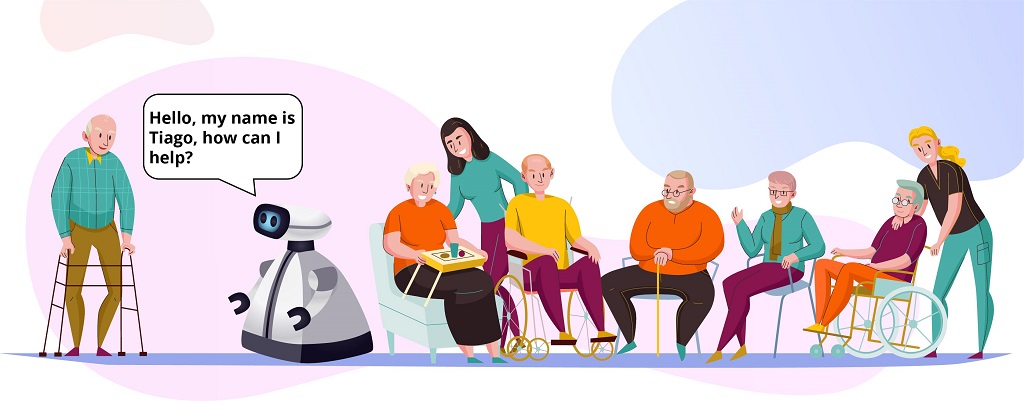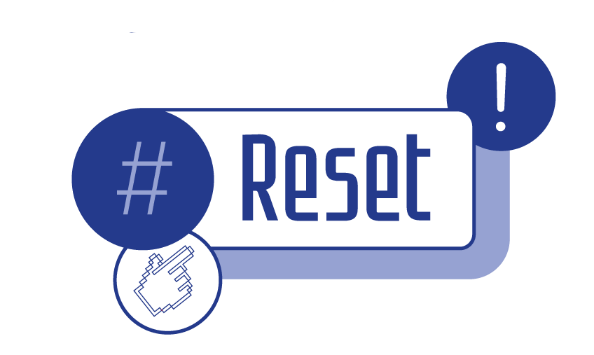While personal coach applications are now ubiquitous, personal lifelong pathway co-construction is largely overlooked, although present for e-learning, healthcare, return to employment, home-care of elders, etc. Modeling generic lifelong pathway co-construction is feasible since these situations share many properties. We contribute to the problematics with a generic model for the co-construction of lifelong pathways applicable in a wide range of situations. Our model supports the interactions between two main actors, the advisee and the advisor, and includes key specific aspects of lifelong pathway: advisee’s long-term goal, multi-dimensional evaluation of advisee’s trajectory (educational, professional, financial, medical, etc.), guiding via advices that influence the stages of the pathway. We also describe a guidance system to support the co-construction, leveraging the proposed model. To illustrate this, we detail the guidance system use, to help the advisee’s work in guiding the advisor towards their goal.
Context
Capturing and modeling the coached evolution of a person according to several possibly independent dimensions is of prime importance in many real life situations.
- Healthcare is a typical case: diagnoses are established before doctors devise patient management and monitor their health over a potentially long period of time.
- In e-learning context, modelling offer complete view of skills and knowledge acquisition states of learners enrolled in different courses. Thus, personalized curriculum can be established, based on prior evaluations of the learner and under the guidance of a teaching staff.
- As for the elderly home support field, it concerns up to 15 million people aged of 60 or more in France. To help maintaining independence, autonomy, mobility or cognitive abilities, preemptively taking action are implemented, as personalized training programs based on a diagnosis of their medical and social conditions.
- Another example: the job seekers assistance which concerns 2.06 millions low resources beneficiaries in 2020 in France may want to model beneficiaries upon social, professional, medical or educational dimensions.
Main objective is to provide the best combined support that improves beneficiaries social integration or financial situation based on prior analysis of their diplomas, past work experiences, social data on housing, family or health condition.

So, what are the commons points to all these scenarios?
- The person whose evolution is under consideration, here after called the advisee, who has a long term goal;
- The entity in charge of supporting and helping advisees to reach their objectives, called the advisor,
- A diagnosis that defines the actual situation of the advisee regarding different dimensions (e.g., health, financial, professional, education, etc.), linked with his objectives
As depicted in Figure 1, an advisor represents the entity in charge of diagnosing and periodically monitoring the advisee’s progresses based on undertaken actions on all dimensions over time, the latter forming the advisee’s life trajectory.
Modeling a lifelong pathway
In this article, we are interested in modeling a lifelong pathway. By lifelong pathway, we consider a set of stages made of tailored actions undertaken by an advisee and the underlying co-construction mechanism, participating in the evolution of this advisee’s life trajectory.
A life-long pathway involves several actors such as the advisee, the advisor or any other stakeholder involved in its co-construction, fulfilling objectives and long term goal of the advisee.
As our experience with data of job seekers assistance suggests, it emerges a need to support the advisor in the tedious exploration of all combinations of actions to offer to an advisee. This lifelong pathway model will be a corner stone in the development of an intelligent system that helps the advisor identifying relevant actions. For instance, this system could be a recommender system that would implements activities in the guidance layer (Figure 1).
While a great deal of work has been done, it does not yet have a generic model able to represent the richness necessary for the above mentioned situations.
Obviously, while the design of lifelong pathway co-construction applications can be conducted without such a model, formalizing guidelines with a conceptual modeling of the domain will drive further researches, and help the understanding, standardization, reuse and sharing best practices around this phenomenon. For example, in our use case of job seekers assistance, we noticed that a variety of platforms are used in different regions, sharing only some common concepts and needs. However, the amount of data, technologies and administrative processes make the design of these applications time consuming and their interoperability challenging. Formal guidelines will make these applications easier to develop, maintain and interoperate around common mechanisms like cross-systems path- ways recommendation.
Though, this needs the introduction of different stakeholders, the most important being the advisee and the advisor, the specification of a long term goal, and with the intervene of an intelligent agent to help co-constructing lifelong pathways.
Requirements
The model should represent:
- A human trajectory: the model should be tailored to the description of the evolution of a person mainly through semantic dimensions, and possibly during a long period of time.
- A long-term goal: the pathway construction is driven by a long term goal (e.g., find a job, treat a disease) that corresponds to milestones in the pathway. Each one can be defined as objective, to enable the monitoring of the evolution of an advisee via a diagnosis, for analytical or suggestion purpose (e.g., urban or demographic study, home support, job finding).
- Multidimensional and multi-granular factors: the model should enable the comprehension of how the trajectory is impacted by internal and external factors, structured around dimensions related to the use case (e.g., health, residence or education) and at different granularity levels (e.g., temporal, geographic or business related) to account for the difficulty to precisely characterize the data related to human situations.
- Pathway co-constructors and influencers : different stakeholders, with different objectives, who participate and impact the construction of the pathway. The advisee, the advisor and external stakeholders (services providers, financing institutions, etc.) have to conciliate their objectives and may express constraints that may bend the trajectory.
The lifelong pathway model
Figure 2 gives a functional overview of our model. It includes 4 components representing the four layers of Figure 1. The Trajectory component is responsible for providing and updating the advisee profile. The Evaluation component refers to assessment of the advisee by analyzing individual’s trajectory. This results in generation of a set of objectives for the advisee. The Guidance component uses these objectives to provide advices to the advisee. Finally the Pathway component uses advices that the advisee agrees with, to build a sequence of stages. These stages impact the advisee’s trajectories, resulting in new episodes and events. Completion of the pathway is determined by a final diagnosis, when the long term goal is reached.

Take up Figure 1: the first step in the global co-construction process is to establish an assessment. This one is based on the advisee’s trajectories. Then, a diagnosis is established. A long term goal and a set of objectives to reach it are defined afterwards. The advisor formulates advices to achieve the objectives, counsels validated by the advisee as well. Once approved, guidances are turned into stages of the lifelong pathway. These stages are undertook by the advisee, which updates their trajectories.
Automating the advisor’s tasks : the guidance system
As explained above, part of the advisor work can be automated. To showcase a practical use of this model, we describes a guidance system to support the advisor’s work of establishing a diagnosis and formulating advice to the advisee. We take advantage of this job seekers assistance use case and our preliminary version of such a system exposed in one of our previous article, to illustrate the contemplated guidance system.

Figure 3 illustrates a model for a generic guidance system. This model formulates different type of Advice: either future actions to help the advisee in its pathway towards its goal (Action advice), or elements to help the advisor in the evaluation of the advisee and its pathway (Diagnosis advice or Objective advice). When suggesting Action advice, the system chooses among actions provided by external actors those that best match the objectives set for the advisee. This selection is made considering inputs from Trajectory, Pathway and Evaluation components. The same inputs may be used when suggesting Objective of Diagnosis advice. For example, diagnosis can be established on basis of former advisees’s diagnoses with similar trajectories and long term goals, or on on basis of undertaken stages failed by the advisee.
Example 1. Consider an Advisee named Alice, whose long term goal is to find a full time job. Her trajectory shows that she lives in a small city, has a young kid and does not have a driving license. There is a first job offer in the city she lives in, but for which having a vehicle is necessary, and two jobs offers in a distant city, one which is close to a child care and another which corresponds more to her qualifications. If the notions of diagnosis, assessment and objectives are not distinguished, and trajectories are only coarsely defined, only simple likelihoods based on the set of advisees can be expressed to make advice. In this case, the guidance system will suggest e.g., the application for a new degree, which is the most popular advice among former advisees, while other advice like registration to a bus service between the two cities, will be overlooked.
Taking advantage of the lifelong pathway co-construction model
In the job seekers use case, the guidance system recommends professional projects for french solidarity income beneficiaries. It primarily predicts relationship between evaluation and advisee’s actions within the observed pathways to recommend complementary actions. As explained above, it does not take into account the advisee’s long-term goal (e.g., being recruited for a precise job) or a finer notion of pathway as a stages sequence. Our lifelong pathway model explicits trajectories, pathways, diagnoses, and objectives attached to a long-term goal for each advisee. In this way, it allows to represent history of items proposed to each advisee and success level in relation to their long-term goal. With this model, new guidance scenarios can be considered, leading to more accurate advice.
For instance, instead of predicting for each action whether it should be added or not to an advisee’s pathway, simple collaborative filtering techniques could be implemented. Leveraging pathway information, a user-item matrix can be constructed from the advisee-action relationship of the pathways and classical recommender system machinery can be deployed. To allow for direct bundle recommendations, the long-term goal, together with the more specific objec- tives that follow the evaluation, will help to determine a subset of other advisee pathways to pick relevant actions from. In this case, following the principles of nearest neighbors recommendation, this needs to devise new similarity measures between objectives, trajectories, pathways or long-term goals.
Guidance could also take advantage of the advisee-goal or advisee-diagnosis relationship. In this case, advisor and advisee do not directly agree on actions to be taken but rather (i) on the selection of relevant objectives from a set of objectives that may be very large or (ii) on the definition of a new diagnosis to search for completely new objectives. Since the model now enables a rich description of advisees and actions provided by external stakeholders, determining the relevance of an action to an advisee can rely on more complex similarity measures based on different conceptual spaces representing actions and pathways, trajectories (episodes, events, etc.), evaluation and assessments. As in any guidance system, actors will only use the system if they trust it. This is the trendy problem of the explainability to any recommendation system. One way to enforce trust in is to propose elements of discussion, or examples that justify the choice of this specific advice to this advisee. In this regard, our model provides access to examples (of other advisees and their pathways, trajectories, and long-term goals) or a rich description of actions, episodes, or events in the advisee’s trajectory that could serve as an interpretable space on which a formal explanation can be learned.
Example 2. Continuing the scenario of Example 1, illustrated in Figure 4, a guidance system implementing the co-construction model will formulate advice as follows. First, the trajectory of Alice is evaluated. From the assessment made, the system suggests a diagnosis where it appears that Alice mobility situation is critical and should be addressed first. The system can also formulate the objec- tive of improving her mobility situation, and suggest action advice of getting a driving license to apply for the job in the city she lives in. Besides, with a fine description of the advisees’ trajectories, the guidance system can base the advice on the similarity of Alice’s trajectory with those of former advisees and suggest action advice of applying for the job in the distant city, using a bus service be- tween the two cities and the child care of that city. This information stored in Alice’s trajectory could eventually serve as an explanation why she applied for a job in a distant city.

Fig. 4. Graphical depiction of Alice’s pathway – Example 2.
Figure 4 uses the color code of the diagrams. The pathway consists of 3 stages, with 3 trajectories composed of episodes, each assessed in terms of criticity (green stars). The pathway evolves with the actions undertaken following the Guidance System suggestions.
To conclude
We are currently working on a generic guidance system implementing the co-construction model. We will experiment it in two contexts for which data are already available to us: the return to employment and the elderly support. As explained, one key challenge will be to enforce the confidence that the advisee will have in the guidance system.





